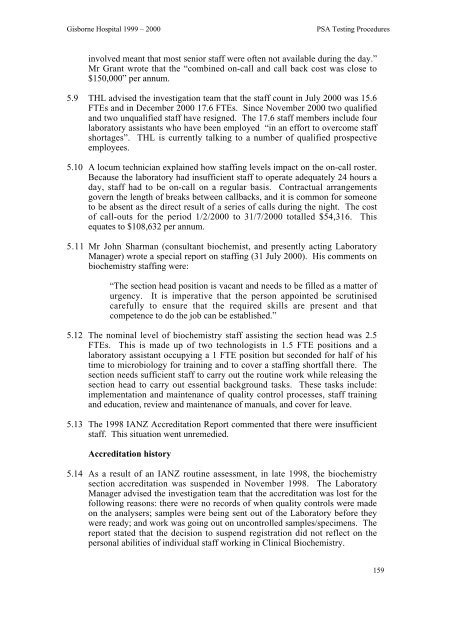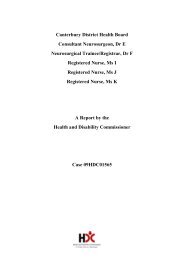Gisborne Hospital Report - Health and Disability Commissioner
Gisborne Hospital Report - Health and Disability Commissioner
Gisborne Hospital Report - Health and Disability Commissioner
Create successful ePaper yourself
Turn your PDF publications into a flip-book with our unique Google optimized e-Paper software.
<strong>Gisborne</strong> <strong>Hospital</strong> 1999 – 2000<br />
PSA Testing Procedures<br />
involved meant that most senior staff were often not available during the day.”<br />
Mr Grant wrote that the “combined on-call <strong>and</strong> call back cost was close to<br />
$150,000” per annum.<br />
5.9 THL advised the investigation team that the staff count in July 2000 was 15.6<br />
FTEs <strong>and</strong> in December 2000 17.6 FTEs. Since November 2000 two qualified<br />
<strong>and</strong> two unqualified staff have resigned. The 17.6 staff members include four<br />
laboratory assistants who have been employed “in an effort to overcome staff<br />
shortages”. THL is currently talking to a number of qualified prospective<br />
employees.<br />
5.10 A locum technician explained how staffing levels impact on the on-call roster.<br />
Because the laboratory had insufficient staff to operate adequately 24 hours a<br />
day, staff had to be on-call on a regular basis. Contractual arrangements<br />
govern the length of breaks between callbacks, <strong>and</strong> it is common for someone<br />
to be absent as the direct result of a series of calls during the night. The cost<br />
of call-outs for the period 1/2/2000 to 31/7/2000 totalled $54,316. This<br />
equates to $108,632 per annum.<br />
5.11 Mr John Sharman (consultant biochemist, <strong>and</strong> presently acting Laboratory<br />
Manager) wrote a special report on staffing (31 July 2000). His comments on<br />
biochemistry staffing were:<br />
“The section head position is vacant <strong>and</strong> needs to be filled as a matter of<br />
urgency. It is imperative that the person appointed be scrutinised<br />
carefully to ensure that the required skills are present <strong>and</strong> that<br />
competence to do the job can be established.”<br />
5.12 The nominal level of biochemistry staff assisting the section head was 2.5<br />
FTEs. This is made up of two technologists in 1.5 FTE positions <strong>and</strong> a<br />
laboratory assistant occupying a 1 FTE position but seconded for half of his<br />
time to microbiology for training <strong>and</strong> to cover a staffing shortfall there. The<br />
section needs sufficient staff to carry out the routine work while releasing the<br />
section head to carry out essential background tasks. These tasks include:<br />
implementation <strong>and</strong> maintenance of quality control processes, staff training<br />
<strong>and</strong> education, review <strong>and</strong> maintenance of manuals, <strong>and</strong> cover for leave.<br />
5.13 The 1998 IANZ Accreditation <strong>Report</strong> commented that there were insufficient<br />
staff. This situation went unremedied.<br />
Accreditation history<br />
5.14 As a result of an IANZ routine assessment, in late 1998, the biochemistry<br />
section accreditation was suspended in November 1998. The Laboratory<br />
Manager advised the investigation team that the accreditation was lost for the<br />
following reasons: there were no records of when quality controls were made<br />
on the analysers; samples were being sent out of the Laboratory before they<br />
were ready; <strong>and</strong> work was going out on uncontrolled samples/specimens. The<br />
report stated that the decision to suspend registration did not reflect on the<br />
personal abilities of individual staff working in Clinical Biochemistry.<br />
159
















